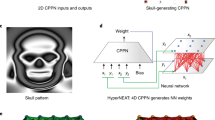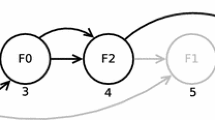Abstract
Neuroevolution is a method for modifying aspects of neural network design in order to learn a specific task. Evolutionary computation is used to discover designs that maximize a fitness function that measures performance in the task. Compared to other neural network learning methods, neuroevolution is highly general, allowing learning without explicit targets and modifying both differentiable and nondifferentiable aspects of the design, such as the architecture, weights, activation and loss functions, and learning algorithms. Neuroevolution thus serves three roles: First, it is a policy search method for reinforcement learning problems, where it is well suited to continuous domains and to domains where the state is only partially observable. Second, it is an automatic method for discovering effective deep learning architectures. Third, especially when combined with learning in individual networks, it is a model of biological adaptation.
Similar content being viewed by others
Recommended Reading
Ackley D, Littman M (1992) Interactions between learning and evolution. In: Langton CG, Taylor C, Farmer JD, Rasmussen S (eds) Artificial life II. Addison-Wesley, Reading, pp 487–509
Angeline PJ, Saunders GM, Pollack JB (1994) An evolutionary algorithm that constructs recurrent neural networks. IEEE Trans Neural Netw 5:54–65
Bingham G, Macke W, Miikkulainen R (2020) Evolutionary optimization of deep learning activation functions. In: Proceedings of the Genetic and Evolutionary Computation Conference (GECCO-2020), Cancun
Bongard J (2011) Morphological change in machines accelerates the evolution of robust behavior. Proc Natl Acad Sci U S A 108:1234–1239
Bryant BD, Miikkulainen R (2007) Acquiring visibly intelligent behavior with example-guided neuroevolution. In: Proceedings of the Twenty-Second National Conference on Artificial Intelligence. AAAI, Menlo Park
Chellapilla K, Fogel DB (1999) Evolution, neural networks, games, and intelligence. Proc IEEE 87:1471–1496
Clune J, Mouret J-B, Lipson H (2013) The evolutionary origins of modularity. Proc R Soc B Biol Sci 280(1755):20122863
Elsken T, Metzen JH, Hutter F (2019) Neural architecture search: a survey. J Mach Learn Res 20:1–21
Floreano D, Dürr P, Mattiussi C (2008) Neuroevolution: from architectures to learning. Evol Intell 1:47–62
Francon O, Gonzalez S, Hodjat B, Meyerson E, Miikkulainen R, Qiu X, Shahrzad H (2020) Effective reinforcement learning through evolutionary surrogate-assisted prescription. In: Proceedings of the Genetic and Evolutionary Computation Conference (GECCO-2020), Cancun
Gomez F, Miikkulainen R (2003) Active guidance for a finless rocket using neuroevolution. In: Proceedings of the Genetic and Evolutionary Computation Conference (GECCO-2003), Chicago
Gomez F, Schmidhuber J, Miikkulainen R (2008) Accelerated neural evolution through cooperatively coevolved synapses. J Mach Learn Res 9:937–965
Gonzalez S, Miikkulainen R (2020) Improved training speed, accuracy, and data utilization via loss function optimization. In: Proceedings of the 2020 IEEE Congress on Evolutionary Computation (CEC-2020), Glasgow
Gruau F, Whitley D (1993) Adding learning to the cellular development of neural networks: evolution and the Baldwin effect. Evol Comput 1:213–233
Igel C (2003) Neuroevolution for reinforcement learning using evolution strategies. In: Sarker R, Reynolds R, Abbass H, Tan KC, McKay B, Essam D, Gedeon T (eds) Proceedings of the 2003 Congress on Evolutionary Computation. IEEE, Piscataway, pp 2588–2595
Keinan A, Sandbank B, Hilgetag CC, Meilijson I, Ruppin E (2006) Axiomatic scalable neurocontroller analysis via the Shapley value. Artif Life 12:333–352
Lehman J, Stanley KO (2010) Abandoning objectives: evolution through the search for novelty alone. Evol Comput 2011:189–223
Lessin D, Fussell D, Miikkulainen R (2013) Open-ended behavioral complexity for evolved virtual creatures. In: Proceedings of the Genetic and Evolutionary Computation Conference (GECCO-2013), Amsterdam
Li A, Spyra O, Perel S, Dalibard V, Jaderberg M, Gu C, Budden D, Harley T, Gupta P (2019) A generalized framework for population based training. In: Proceedings of the 25th ACM SIGKDD International Conference on Knowledge Discovery & Data Mining, pp 1791–1799
Liang J, Meyerson E, Miikkulainen R (2018) Evolutionary architecture search for deep multitask networks. In: Proceedings of the Genetic and Evolutionary Computation Conference (GECCO-2018), Kyoto
Liang J, Meyerson E, Fink D, Mutch K, Miikkulainen R (2019) Evolutionary neural AutoML for deep learning. In: Proceedings of the Genetic and Evolutionary Computation Conference (GECCO-2019), Prague
Liang J, Gonzalez S, Miikkulainen R (2020) Population-based training for loss function optimization. arXiv:2002.04225
Liu Y, Yao X, Higuchi T (2000) Evolutionary ensembles with negative correlation learning. IEEE Trans Evol Comput 4:380–387
Loshchilov I, Hutter F (2016) CMA-ES for hyperparameter optimization of deep neural networks. In: International Conference on Learning Representations (ICLR-2016) Workshop Track
Meyerson E, Miikkulainen R (2018) Pseudo-task augmentation: from deep multitask learning to intratask sharing—and back. In: Proceedings of the 35th International Conference on Machine Learning (ICML-2018), Stockholm
Meyerson E, Miikkulainen R (2019) Modular universal reparameterization: deep multi-task learning across diverse domains. In: Proceedings of the 33rd Annual Conference on Neural Information Processing Systems (NeurIPS-2019), Vancouver
Miikkulainen R (2019) Creative AI through evolutionary computation. In: Banzhaf W et al (eds) Evolution in action: past, present and future. Springer, New York
Miikkulainen R, Bryant BD, Cornelius R, Karpov IV, Stanley KO, Yong CH (2006) Computational intelligence in games. In: Yen GY, Fogel DB (eds) Computational intelligence: principles and practice, Piscataway. IEEE Computational Intelligence Society
Miikkulainen R, Meyerson E, Liang J, Rawal A, Shahrzad H, Fink D, Francon O, Raju B, Navruzyan A, Hodjat B, Duffy N (2018) Evolving deep neural networks. In: Morabito CF, Alippi C, Choe Y, Kozma R (eds) Artificial intelligence in the age of neural networks and brain computing. Elsevier, New York
Moriarty DE, Schultz AC, Grefenstette JJ (1999) Evolutionary algorithms for reinforcement learning. J Artif Intell Res 11:199–229
Mouret J-B, Doncieux S (2012) Encouraging behavioral diversity in evolutionary robotics: an empirical study. Evol Comput 20:91–133
Nolfi S, Floreano D (2000) Evolutionary robotics. MIT Press, Cambridge
Potter MA, Jong KAD (2000) Cooperative coevolution: an architecture for evolving coadapted subcomponents. Evol Comput 8:1–29
Rajagopalan P, Holekamp KE, Miikkulainen R (2020) Evolution of complex coordinated behavior. In: Proceedings of the 2020 IEEE Congress on Evolutionary Computation (CEC-2020), Glasgow
Rawal A, Liang J, Miikkulainen R (2020) Discovering gated recurrent neural network architectures. In: Iab H, Noman N (eds) Deep neural evolution – deep learning with evolutionary computation. Springer, New York
Real E, Aggarwal A, Huang Y, Le QV (2019) Regularized evolution for image classifier architecture search. In: Proceedings of the AAAI Conference on Artificial Intelligence
Real E, Liang C, So DR, Le QV (2020) AutoML-zero: evolving machine learning algorithms from scratch. arXiv:2003.03384
Risi S, Togelius J (2017) Neuroevolution in games: state of the art and open challenges. IEEE Trans Comput Intell AI Games 9:25–41
Schaffer JD, Whitley D, Eshelman LJ (1992) Combinations of genetic algorithms and neural networks: a survey of the state of the art. In: Whitley D, Schaffer J (eds) Proceedings of the International Workshop on Combinations of Genetic Algorithms and Neural Networks. IEEE Computer Society Press, Los Alamitos, pp 1–37
Schrum J, Miikkulainen R (2016) Discovering multimodal behavior in Ms. Pac-Man through evolution of modular neural networks. IEEE Trans Comput Intell AI Games 8:67–81
Stanley KO, D’Ambrosio DB, Gauci J (2009) A hypercube-based encoding for evolving large-scale neural networks. Artif Life 15(2):185–212
Stanley KO, Miikkulainen R (2003) A taxonomy for artificial embryogeny. Artif Life 9(2):93–130
Stanley KO, Miikkulainen R (2004) Competitive coevolution through evolutionary complexification. J Artif Intell Res 21:63–100
Stanley KO, Lehman J (2015) Why greatness cannot be planned: the Myth of the objective. Springer, New York
Stanley KO, Clune J, Lehman J, Miikkulainen R (2019) Designing neural networks through evolutionary algorithms. Nat Mach Intell 1:24–35
Such FP, Madhavan V, Conti E, Lehman J, Stanley KO, Clune J (2017) Deep neuroevolution: genetic algorithms are a competitive alternative for training deep neural networks for reinforcement learning. arXiv:1712.06567
Togelius J, Lucas SM (2006) Evolving robust and specialized car racing skills. In: IEEE congress on evolutionary computation. IEEE, Piscataway, pp 1187–1194
Valsalam V, Hiller J, MacCurdy R, Lipson H, Miikkulainen R (2013) Constructing controllers for physical multilegged robots using the enso neuroevolution approach. Evol Intell 14:303–331
Werner GM, Dyer MG (1992) Evolution of communication in artificial organisms. In: Langton CG, Taylor C, Farmer JD, Rasmussen S (eds) Proceedings of the Workshop on Artificial Life (ALIFE’90). Addison-Wesley, Reading, pp 659 –687
Yao X (1999) Evolving artificial neural networks. Proc IEEE 87(9):1423–1447
Author information
Authors and Affiliations
Corresponding author
Editor information
Editors and Affiliations
Rights and permissions
Copyright information
© 2023 Springer Science+Business Media, LLC, part of Springer Nature
About this entry
Cite this entry
Miikkulainen, R. (2023). Neuroevolution. In: Phung, D., Webb, G.I., Sammut, C. (eds) Encyclopedia of Machine Learning and Data Science. Springer, New York, NY. https://doi.org/10.1007/978-1-4899-7502-7_594-2
Download citation
DOI: https://doi.org/10.1007/978-1-4899-7502-7_594-2
Published:
Publisher Name: Springer, New York, NY
Print ISBN: 978-1-4899-7502-7
Online ISBN: 978-1-4899-7502-7
eBook Packages: Springer Reference Computer SciencesReference Module Computer Science and Engineering
Publish with us
Chapter history
-
Latest
Neuroevolution- Published:
- 07 December 2022
DOI: https://doi.org/10.1007/978-1-4899-7502-7_594-2
-
Original
Neuroevolution- Published:
- 29 April 2015
DOI: https://doi.org/10.1007/978-1-4899-7502-7_594-1




